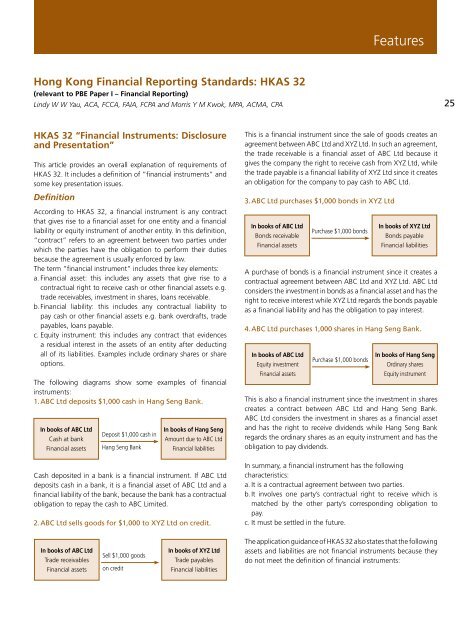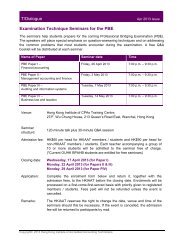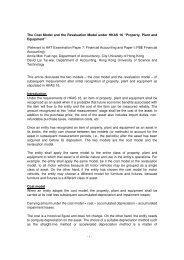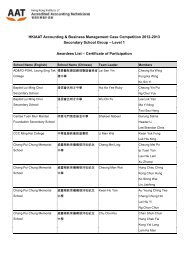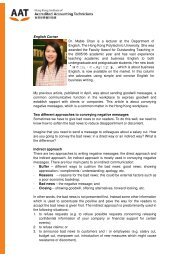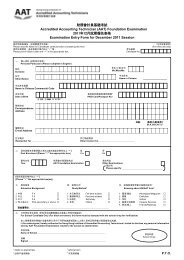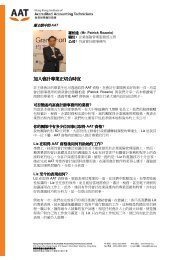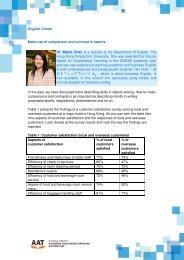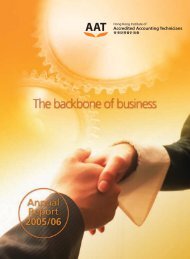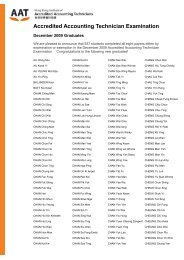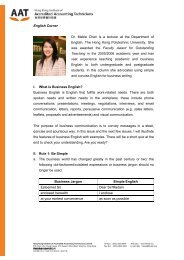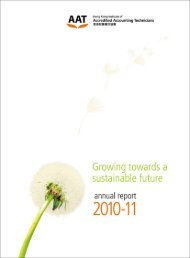HKAS 32 Financial Instruments: Disclosure and Presentation
HKAS 32 Financial Instruments: Disclosure and Presentation
HKAS 32 Financial Instruments: Disclosure and Presentation
Create successful ePaper yourself
Turn your PDF publications into a flip-book with our unique Google optimized e-Paper software.
Features<br />
Hong Kong <strong>Financial</strong> Reporting St<strong>and</strong>ards: <strong>HKAS</strong> <strong>32</strong><br />
(relevant to PBE Paper I – <strong>Financial</strong> Reporting)<br />
Lindy W W Yau, ACA, FCCA, FAIA, FCPA <strong>and</strong> Morris Y M Kwok, MPA, ACMA, CPA<br />
25<br />
<strong>HKAS</strong> <strong>32</strong> “<strong>Financial</strong> <strong>Instruments</strong>: <strong>Disclosure</strong><br />
<strong>and</strong> <strong>Presentation</strong>”<br />
This article provides an overall explanation of requirements of<br />
<strong>HKAS</strong> <strong>32</strong>. It includes a definition of “financial instruments” <strong>and</strong><br />
some key presentation issues.<br />
Definition<br />
According to <strong>HKAS</strong> <strong>32</strong>, a financial instrument is any contract<br />
that gives rise to a financial asset for one entity <strong>and</strong> a financial<br />
liability or equity instrument of another entity. In this definition,<br />
“contract” refers to an agreement between two parties under<br />
which the parties have the obligation to perform their duties<br />
because the agreement is usually enforced by law.<br />
The term “financial instrument” includes three key elements:<br />
a. <strong>Financial</strong> asset: this includes any assets that give rise to a<br />
contractual right to receive cash or other financial assets e.g.<br />
trade receivables, investment in shares, loans receivable.<br />
b.<strong>Financial</strong> liability: this includes any contractual liability to<br />
pay cash or other financial assets e.g. bank overdrafts, trade<br />
payables, loans payable.<br />
c. Equity instrument: this includes any contract that evidences<br />
a residual interest in the assets of an entity after deducting<br />
all of its liabilities. Examples include ordinary shares or share<br />
options.<br />
The following diagrams show some examples of financial<br />
instruments:<br />
1.ABC Ltd deposits $1,000 cash in Hang Seng Bank.<br />
In books of ABC Ltd<br />
Cash at bank<br />
<strong>Financial</strong> assets<br />
Deposit $1,000 cash in<br />
Hang Seng Bank<br />
In books of Hang Seng<br />
Amount due to ABC Ltd<br />
<strong>Financial</strong> liabilities<br />
Cash deposited in a bank is a financial instrument. If ABC Ltd<br />
deposits cash in a bank, it is a financial asset of ABC Ltd <strong>and</strong> a<br />
financial liability of the bank, because the bank has a contractual<br />
obligation to repay the cash to ABC Limited.<br />
2.ABC Ltd sells goods for $1,000 to XYZ Ltd on credit.<br />
This is a financial instrument since the sale of goods creates an<br />
agreement between ABC Ltd <strong>and</strong> XYZ Ltd. In such an agreement,<br />
the trade receivable is a financial asset of ABC Ltd because it<br />
gives the company the right to receive cash from XYZ Ltd, while<br />
the trade payable is a financial liability of XYZ Ltd since it creates<br />
an obligation for the company to pay cash to ABC Ltd.<br />
3.ABC Ltd purchases $1,000 bonds in XYZ Ltd<br />
In books of ABC Ltd<br />
Bonds receivable<br />
<strong>Financial</strong> assets<br />
A purchase of bonds is a financial instrument since it creates a<br />
contractual agreement between ABC Ltd <strong>and</strong> XYZ Ltd. ABC Ltd<br />
considers the investment in bonds as a financial asset <strong>and</strong> has the<br />
right to receive interest while XYZ Ltd regards the bonds payable<br />
as a financial liability <strong>and</strong> has the obligation to pay interest.<br />
4.ABC Ltd purchases 1,000 shares in Hang Seng Bank.<br />
In books of ABC Ltd<br />
Equity investment<br />
<strong>Financial</strong> assets<br />
Purchase $1,000 bonds<br />
Purchase $1,000 bonds<br />
In books of XYZ Ltd<br />
Bonds payable<br />
<strong>Financial</strong> liabilities<br />
In books of Hang Seng<br />
Ordinary shares<br />
Equity instrument<br />
This is also a financial instrument since the investment in shares<br />
creates a contract between ABC Ltd <strong>and</strong> Hang Seng Bank.<br />
ABC Ltd considers the investment in shares as a financial asset<br />
<strong>and</strong> has the right to receive dividends while Hang Seng Bank<br />
regards the ordinary shares as an equity instrument <strong>and</strong> has the<br />
obligation to pay dividends.<br />
In summary, a financial instrument has the following<br />
characteristics:<br />
a. It is a contractual agreement between two parties.<br />
b.It involves one party’s contractual right to receive which is<br />
matched by the other party’s corresponding obligation to<br />
pay.<br />
c. It must be settled in the future.<br />
In books of ABC Ltd<br />
Trade receivables<br />
<strong>Financial</strong> assets<br />
Sell $1,000 goods<br />
on credit<br />
In books of XYZ Ltd<br />
Trade payables<br />
<strong>Financial</strong> liabilities<br />
The application guidance of <strong>HKAS</strong> <strong>32</strong> also states that the following<br />
assets <strong>and</strong> liabilities are not financial instruments because they<br />
do not meet the definition of financial instruments:
Features<br />
26<br />
Tangible <strong>and</strong><br />
intangible assets<br />
Prepaid expenses<br />
Deferred revenue<br />
Warranty<br />
obligations<br />
Income tax assets<br />
or liabilities<br />
Constructive<br />
obligation<br />
Tangible <strong>and</strong> intangible assets (such as<br />
property, plant <strong>and</strong> equipment, patent<br />
<strong>and</strong> trademarks) are not financial assets<br />
since they only generate an inflow of<br />
cash but do not give rise to a present<br />
right to receive cash or other financial<br />
assets.<br />
Such assets are associated with the<br />
receipt of goods or services, rather than<br />
the right to receive cash or other financial<br />
assets.<br />
Such liabilities are associated with the<br />
future delivery of goods or services.<br />
They do not give rise to a contractual<br />
obligation to pay cash or any other<br />
financial asset.<br />
Such items are not financial liabilities<br />
<strong>and</strong> they are associated with the future<br />
delivery of goods or services but do not<br />
give rise to a contractual obligation to<br />
pay cash or another financial assets.<br />
Such items are not contractual but are<br />
imposed by statutory requirements.<br />
Such items do not arise from contracts<br />
<strong>and</strong> are not financial liabilities.<br />
Example 1<br />
Identify which of the following are financial instruments:<br />
a. Purchase 15 percent voting ordinary shares<br />
b.Purchase 25 percent voting ordinary shares<br />
c. A liability for profits tax<br />
d.Prepayments for goods or services<br />
e. Issued debt instruments<br />
f. Inform employee <strong>and</strong> make a promise to raise salary<br />
a. An investment in 15 percent of a company’s equity is a<br />
financial instrument. This is a financial asset because the<br />
investor has the right to receive dividends from the issuer of<br />
the ordinary shares.<br />
b.A purchase of 25 percent of voting ordinary shares is also<br />
a financial instrument. However, holding 25 percent of the<br />
shares in a company implies that the investor has significant<br />
influence over the investee. Such an investment is generally<br />
outside the scope of <strong>HKAS</strong> <strong>32</strong> <strong>and</strong> is accounted for as an<br />
investment in an associate instead.<br />
c. Profits tax liability is not a financial liability because it does<br />
not arise from contractual rights or obligations, but from<br />
statutory requirements.<br />
d.Prepayments for goods or services are not financial assets<br />
because they are associated with the receipt of goods or<br />
services. They do not give rise to a present right to receive<br />
cash or any other financial asset.<br />
e. Issued debt instruments meet the definition of a financial<br />
liability because the issuer has to pay regular interest <strong>and</strong><br />
the principal on maturity.<br />
f. This is a constructive obligation which does not arise from<br />
contracts <strong>and</strong> is not a financial liability.<br />
<strong>Presentation</strong> issues<br />
The st<strong>and</strong>ard has some rules for the presentation of financial<br />
instruments:<br />
1.Classification as liabilities or equity<br />
<strong>HKAS</strong> <strong>32</strong> indicates that when identifying a financial<br />
instrument as debt or equity, classification should be based<br />
on the substance of the contractual agreement rather than<br />
legal form. For example, the issue of ordinary shares that are<br />
redeemable at the option of the holder is equity in legal form,<br />
but in substance it meets the definition of a financial liability.<br />
A critical principle that should be used to differentiate a<br />
financial liability from an equity instrument is the existence of<br />
a contractual obligation that meets the definition of a financial<br />
liability. For example, the owner of an equity instrument is<br />
entitled to receive dividends, but the company does not have<br />
a contractual obligation to make the payment. Therefore,<br />
<strong>HKAS</strong> <strong>32</strong> provides the two specific conditions below must be<br />
met in order to classify a contract as an equity instrument:<br />
Does not meet the<br />
definition of financial<br />
liabilities*?<br />
YES<br />
Settled in issuer’s own<br />
equity instruments?<br />
YES<br />
Equity instrument<br />
NO<br />
NO<br />
<strong>Financial</strong><br />
liabilities<br />
* Definition of financial liabilities:<br />
Contractual obligation to deliver<br />
cash or other financial asset to<br />
another entity on potentially<br />
unfavourable terms.<br />
Example 2<br />
Suppose ABC Limited has the following financial instruments:<br />
1.A cumulative <strong>and</strong> redeemable preference share<br />
2.An issued share option<br />
3.A 10 percent perpetual bond<br />
4.A forward contract to repurchase a fixed number of its own<br />
shares for a fixed amount of cash<br />
Discuss <strong>and</strong> classify the above financial instruments as financial<br />
liabilities or equity in accordance with <strong>HKAS</strong> <strong>32</strong>.<br />
1.A cumulative <strong>and</strong> redeemable preference share is a<br />
financial liability since ABC Limited has an obligation to pay<br />
cumulative dividends <strong>and</strong> to repay the amount to the holder<br />
when it is redeemed.<br />
2.An issued share option is an equity instrument since this is<br />
a contract under which ABC Limited should deliver a fixed<br />
number of its own shares for settlement.<br />
3.A 10 percent perpetual bond that pays 10 percent interest<br />
each year should be classified as a financial liability. Such<br />
an instrument contains an obligation to pay interest <strong>and</strong> it<br />
meets the definition of a financial liability.<br />
4.A forward contract is a financial liability since ABC Limited<br />
has an obligation to pay a fixed amount of cash to repurchase<br />
a fixed amount of its own shares. This meets the definition<br />
of a financial liability.
Features<br />
2.Compound financial instruments<br />
Compound financial instruments are financial instruments<br />
which contain both a liability <strong>and</strong> an equity component.<br />
For example, a convertible bond is a compound financial<br />
instrument because it contains an obligation to pay interest<br />
<strong>and</strong> principal payment <strong>and</strong> grants an option to the holder<br />
to convert it into a fixed number of ordinary shares. <strong>HKAS</strong><br />
<strong>32</strong> requires such components to be presented separately<br />
using split accounting. The following table shows how split<br />
accounting should be used to separate the liability <strong>and</strong> equity<br />
components of compound financial instruments.<br />
Item<br />
Measurement basis<br />
3.Treasury shares<br />
If an entity’s own equity instruments are reacquired by the<br />
entity or by other members of the consolidated group, they<br />
are treasury shares. According to <strong>HKAS</strong> <strong>32</strong>, treasury shares<br />
should not be classified as financial assets regardless of the<br />
reason for which they are reacquired. Instead, they should<br />
be presented as deductions from shareholders’ equity in the<br />
balance sheet.<br />
Example 4<br />
ABC Limited issues 1,000 shares of $1 each at $1.1 at the<br />
start of year one. At the end of year one, the company<br />
reacquired 400 of its shares for $1.2. The company has a<br />
retained profit of $700 at the end of year one.<br />
27<br />
Convertible bonds<br />
Use proceeds received in issuing the<br />
convertible bonds (A)<br />
According to <strong>HKAS</strong> <strong>32</strong>, the treasury shares are not financial<br />
assets. Therefore, the journal entry at end of year one is:<br />
Liability component<br />
of convertible bonds<br />
Equity component of<br />
convertible bonds<br />
Use the fair value of similar bonds or<br />
present value of future cash flow from<br />
convertible bonds (B)<br />
A – B<br />
Example 3<br />
ABC Limited issues 5 percent convertible bonds with a nominal<br />
value of $90,000 at $100,000 at the start of year one. The<br />
bonds have a three-year term <strong>and</strong> the interest is payable at<br />
end of each year. The interest rate for a similar bond without<br />
any equity component is 10 percent.<br />
The liability component is the fair value of a similar financial<br />
liability without an equity component, which is determined<br />
as follows:<br />
Present value of the principal 90,000/(1+10%) 3 67,618<br />
Present value of the interest 4,500 /(1+10%)+<br />
4,500/(1+10%) 2 +4,500/(1+10%) 3 11,191<br />
Total liability component 78,809<br />
Equity component (balancing figure) 21,191<br />
Fair value of convertible bonds 100,000<br />
The journal entry for year one is:<br />
Bank 100,000<br />
$<br />
Dr $ Cr $<br />
Bond payable 78,809<br />
Equity 21,191<br />
Treasury shares 400 x $1.2 480<br />
Dr $ Cr $<br />
Bank 480<br />
Extract from balance sheet showing the balance of<br />
shareholders’ equity as at the end of year one:<br />
Share capital 1,000<br />
Share premium 1,000 x $0.1 100<br />
Retained profits 700<br />
Treasury shares (480)<br />
Total shareholders’ equity 1,<strong>32</strong>0<br />
<strong>HKAS</strong> <strong>32</strong> further provides that no gain or loss should be<br />
recognized in the profit <strong>and</strong> loss account on the purchase, sale,<br />
issue or cancellation of an entity’s own equity instruments.<br />
Consideration received or paid arising from repurchases or sale<br />
of treasury shares should be recognized directly in equity.<br />
4.<strong>Presentation</strong> of interest, dividends, losses or gains<br />
The classification of a financial instrument as a liability or<br />
equity determines whether interest, dividends, losses <strong>and</strong><br />
gains relating to that instrument are recognized in income<br />
statement or directly in equity.<br />
a.Interest, dividends, losses or gains arises from a financial<br />
liability should be recorded as income or expenses in the<br />
income statement. For example, dividends payable to the<br />
holders of redeemable <strong>and</strong> cumulative preference shares are<br />
recognized in the income statement as an item of expense<br />
since the redeemable preference shares are financial<br />
liabilities.<br />
b.Interest, dividends, losses or gains arising from an equity<br />
instrument should be recorded in equity. For example, gains<br />
$
Features<br />
28<br />
or losses on the fair value of equity instruments of the entity<br />
are recorded in equity.<br />
The following diagram summarizes the above accounting<br />
treatment for presentation of interest, dividends, losses or<br />
gains:<br />
Interest, dividends,<br />
losses or gains<br />
Arising from<br />
financial liability<br />
Arising from equity<br />
instrument<br />
Record as income<br />
or expenses<br />
Debited to equity<br />
<strong>and</strong> be shown in<br />
the statement of<br />
changes in equity<br />
5. Offsetting of financial assets <strong>and</strong> liabilities<br />
The general rule is that financial assets <strong>and</strong> financial liabilities<br />
should not be offset in the balance sheet. However, <strong>HKAS</strong> <strong>32</strong><br />
allows financial assets <strong>and</strong> financial liabilities to be offset <strong>and</strong><br />
the net amount presented in the balance sheet when both the<br />
following conditions are met:<br />
a.the entity currently has a legally enforceable right to set off<br />
the recognized amounts; <strong>and</strong><br />
b.the entity intends either to settle on a net basis, or to<br />
realize the assets <strong>and</strong> settle the liabilities simultaneously.<br />
For example, if ABC Limited sells to <strong>and</strong> buys from XYZ Limited<br />
<strong>and</strong> both parties agree to settle on a net basis at end of each<br />
month, the amount due to <strong>and</strong> the amount due from XYZ<br />
Limited should be offset <strong>and</strong> net amount presented on the<br />
balance sheet of ABC Limited.<br />
Offsetting does not mean derecognition. In other words, both<br />
financial assets <strong>and</strong> financial liabilities are still recorded in the<br />
appropriate accounts in the books of the entity. But for balance<br />
sheet presentation, they are netted off <strong>and</strong> presented as a single<br />
item.<br />
St. Perth Ad<br />
The HKIAAT would not be held responsible for the content of the advertisement.


